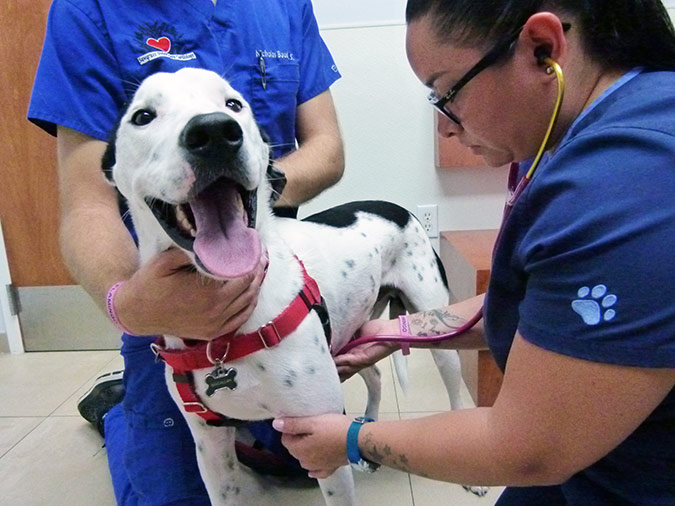Complete Preparation Tips Before Scheduling CT Scans For Animals}
What You Need to Know Concerning Vet Solutions: A Review of Diagnostic Devices and Procedures
Vet services play an important duty in maintaining the health of pets. Regular check-ups can disclose concealed wellness problems at an early stage. Different diagnostic tools and treatments, such as blood tests and imaging techniques, provide essential insights into a pet's health. Comprehending these techniques is key for animal proprietors. What specific diagnostic treatments are most commonly utilized, and exactly how can they influence a pet's treatment strategy?
Relevance of Regular Veterinary Examinations
While several pet owners may ignore the relevance of normal vet exams, these appointments are important for preserving a pet's total health. Routine check outs to the veterinarian enable early detection of potential health and wellness problems prior to they rise into major issues. Routine examinations often consist of inoculations, which are very important for preventing contagious illness that could seriously influence a pet's health. Additionally, these visits supply a chance for veterinarians to evaluate the animal's weight, dental wellness, and overall problem, guaranteeing that the animal is growing. Throughout these sees, family pet owners can additionally obtain beneficial guidance on diet plan, exercise, and preventive care customized to their details pet dog's demands.
Usual Analysis Treatments in Vet Medicine
In vet medication, accurate diagnosis is essential for effective therapy. Typical diagnostic treatments include blood screening techniques, progressed imaging modern technologies, and urinalysis, each playing a significant duty in determining health and wellness issues. Understanding these methods boosts the capability to offer appropriate look after animal people.
Blood Checking Methods
Blood testing strategies work as essential analysis devices in veterinary medicine, making it possible for veterinarians to assess the wellness of animals precisely. These techniques entail accumulating blood samples to assess numerous elements, such as white and red blood cells, platelets, and biochemical pens. Common tests consist of complete blood counts (CBC), which review overall wellness and identify infections, and biochemical panels, which examine organ feature and metabolic condition. Furthermore, serological examinations can identify certain illness via antibody detection. Blood screening is minimally intrusive and provides vital details that assists in detecting problems, keeping track of wellness status, and reviewing responses to therapies. Overall, these methods play a vital role in ensuring optimal take care of pets and livestock alike.
Imaging Technologies Used
Diagnostic imaging technologies are vital tools in veterinary medicine, matching blood testing methods by supplying aesthetic insights into an animal's interior structures. Common imaging modalities consist of X-rays, which work for evaluating bone cracks and spotting international things, and ultrasound, which allows for real-time visualization of soft tissues and body organs. Magnetic vibration imaging (MRI) provides in-depth images of complicated anatomical areas, particularly in neurological assessments. Computed tomography (CT) offers cross-sectional photos, boosting analysis precision for different conditions. Each of these modern technologies help veterinarians in diagnosing ailments, planning therapies, and checking recovery. By incorporating imaging technologies, vet specialists can much better examine an animal's wellness and make notified decisions concerning their care.
Urinalysis and Diagnostics
Urinalysis acts as an important analysis device in veterinary medication, giving useful insights into an animal's total health and wellness and helping in the detection of numerous problems. This non-invasive procedure evaluates pee samples to assess kidney function, hydration standing, and metabolic conditions. Common parts taken a look at include certain gravity, pH levels, sugar, healthy proteins, and the existence of blood or bacteria. Irregular searchings for can suggest problems such as urinary system infections, diabetes mellitus, or kidney condition. To enhance analysis accuracy, urinalysis is often done along with other examinations, such as blood work and imaging studies. Early discovery with urinalysis can lead to prompt treatments, enhancing the prognosis for lots of veterinary clients. It is an essential element of thorough veterinary treatment.
Understanding Blood Examinations and Research Laboratory Analysis
Recognizing blood examinations and lab evaluation is vital in veterinary medication as it assists in detecting numerous wellness problems in animals. Various sorts of blood examinations give vital details about an animal's inner state, while analyzing lab results needs mindful consideration of various factors. This section will certainly discover the kinds of blood tests offered and the value of their outcomes.
Kinds of Blood Examinations
Blood tests play an important function in veterinary medication, giving important insights into an animal's health and wellness condition. Numerous kinds of blood examinations are made use of, each offering various objectives. Total blood counts (CBC) evaluate general health and find problems such as anemia or infection. Biochemical accounts review organ feature by gauging electrolytes and enzymes, offering understandings into metabolic health. Serological tests identify specific antibodies or pathogens, aiding in the medical diagnosis of infections or autoimmune conditions. Blood keying warranties secure transfusions, while coagulation examinations assess the blood's capability to clot, important for surgical procedures. These tests collectively enhance diagnosis, therapy preparation, and tracking of an animal's health, illustrating the importance of comprehensive laboratory evaluation in vet care.

Interpreting Lab Results
A detailed evaluation of lab results is necessary for precise medical diagnosis and therapy in veterinary medicine. Translating laboratory results needs an understanding of regular referral link ranges and the significance of discrepancies. Blood tests can expose different wellness signs, such as body organ function, electrolyte balance, and the existence of infections. Vets must consider the entire clinical image, consisting of the pet's history, checkup searchings for, and any type of signs presented. Variations in outcomes might develop from factors such as age, breed, and underlying health and wellness conditions. Laboratory outcomes must not be seen in isolation but rather as part of an all-inclusive analysis strategy. Exact analysis enables for customized therapy strategies and much better outcomes for veterinary people.
Imaging Techniques: X-rays, Ultrasounds, and Beyond
Imaging methods are vital tools in veterinary medicine, supplying critical understandings right into the health and wellness and health of animals. Among one of the most frequently used techniques are X-rays and ultrasounds. X-rays are invaluable for visualizing bone frameworks, aiding vets recognize cracks, tumors, or international objects. This approach is quick and non-invasive, making it suitable for immediate situations.Ultrasounds, on the various other hand, utilize acoustic waves to develop pictures of soft cells and organs. This method is particularly beneficial for analyzing the heart, abdominal area, and reproductive body organs, allowing veterinarians to find more examine problems like fluid build-up or body organ abnormalities.Beyond X-rays and ultrasounds, progressed imaging techniques such as computed tomography (CT) and magnetic vibration imaging (MRI) are progressively utilized in vet technique. These methods use detailed cross-sectional photos, enhancing the precision of diagnoses and therapy strategies. CT Scans For Dogs. In general, imaging strategies play a necessary role in guaranteeing efficient vet treatment
The Duty of Biopsies in Diagnosing Family Pet Health And Wellness Issues
Precision in detecting health issues in animals usually depends upon making use of biopsies, which offer conclusive details about tissue irregularities. A biopsy involves the removal of a tiny example of tissue for exam under a microscope, enabling veterinarians to recognize various problems, consisting of infections, tumors, and inflammatory illness. This diagnostic tool is crucial for comparing benign and malignant growths, directing treatment decisions, and evaluating the severity of a condition.Biopsies can be performed making use of different strategies, such as needle goal, incisional biopsies, or excisional biopsies, depending upon the place and kind of tissue involved. The selection of approach might influence recuperation time and the quantity of cells gathered. Eventually, the information amassed from a biopsy can bring about targeted treatments, enhancing end results for pets facing serious wellness difficulties. Veterinarians emphasize the importance of this procedure in accomplishing accurate diagnoses and effective therapy strategies.
Advanced Diagnostic Devices: Endoscopy and CT Checks

Advanced analysis tools, such as endoscopy and CT scans, play an essential function in modern-day veterinary medication, using non-invasive methods to visualize inner structures and detect different problems in pet dogs. Endoscopy includes making use of an adaptable tube geared up with an electronic camera, permitting veterinarians to check out the intestinal system and respiratory system directly. This method can reveal irregularities such as lumps, foreign bodies, or swelling, enabling targeted therapy plans.CT scans, on the various other hand, make use of sophisticated imaging technology to produce thorough cross-sectional photos of the body (Board Certified Veterinary Cardiologist). This approach is especially valuable for reviewing complex structures like the brain, back, and joints. By offering high-resolution pictures, CT scans help veterinarians in determining problems that may not be noticeable via typical radiography. Together, these advanced tools enhance diagnostic accuracy, boost therapy outcomes, and inevitably add to far better total family pet wellness monitoring

Interpreting Examination Outcomes: What Family Pet Owners Should Know
Comprehending test outcomes can be a tough task for animal owners, specifically after sophisticated procedures like endoscopy and CT scans have actually been done. Translating these results needs an understanding of medical terminology and a clear understanding of what the searchings for indicate regarding the pet dog's health. Vets frequently offer descriptions, but the complexity of the outcomes can still lead to confusion.Pet proprietors need to proactively engage in discussions with their vets, asking inquiries to clarify any type of unpredictabilities. It is important to comprehend regular versus abnormal outcomes and the effects for the pet's treatment plan. Furthermore, acknowledging that some outcomes may need more testing or tracking can assist proprietors remain educated about their pet's health and wellness trip. Ultimately, a collaborative method between animal proprietors and vet professionals promotes much better health and wellness outcomes and boosts the overall care experience for pets.
Frequently Asked Inquiries
Just how Do I Choose the Right Vet Center for My Pet?
Choosing the right veterinary facility entails looking into neighborhood alternatives, assessing certifications, going to facilities, and assessing staff communications (Cancer Veterinary Near Me). Focusing on referrals from relied on sources can help assure the very best treatment and atmosphere for a pet's health requirements
What Should I Do if My Pet Refuses to Go to the Vet?
When an animal refuses to head to the vet, it's suggested to stay tranquil, usage treats or playthings to tempt them, and take into consideration scheduling a home go to if anxiety lingers. Perseverance and favorable reinforcement are key.
Exist Telehealth Options for Veterinary Solutions?
Telehealth options for veterinary services are progressively offered, enabling animal owners to talk to vets remotely. These services make it possible for conversations regarding health and wellness worries, recommendations on minor ailments, and follow-ups without needing to see a clinic.
Exactly how Commonly Should My Family Pet Have Dental Check-Ups?
The regularity of dental check-ups for animals generally depends on their age and breed. Generally, vets suggest annual dental analyses, although some pet dogs might need more constant brows through to maintain perfect oral health.

What Are the Expenses Connected With Veterinary Diagnostics?
The expenses connected with vet diagnostics can vary widely, normally varying from standard examinations like blood job to innovative imaging strategies. Factors influencing expenses include the center's place, tools made use of, and particular examinations required for every animal. Veterinary services play an essential duty in preserving the wellness anonymous of pets. While many pet owners might undervalue the relevance of routine veterinary exams, these appointments are crucial for maintaining a pet's total wellness. In addition, these consultations give a possibility for vets to examine the pet's weight, oral health, and general condition, making sure that the family pet is prospering. Accuracy in detecting health issues in animals typically hinges on the use of biopsies, which offer conclusive details concerning tissue problems. In addition, identifying that some results may call for additional testing or monitoring can aid proprietors stay informed about their animal's wellness journey.